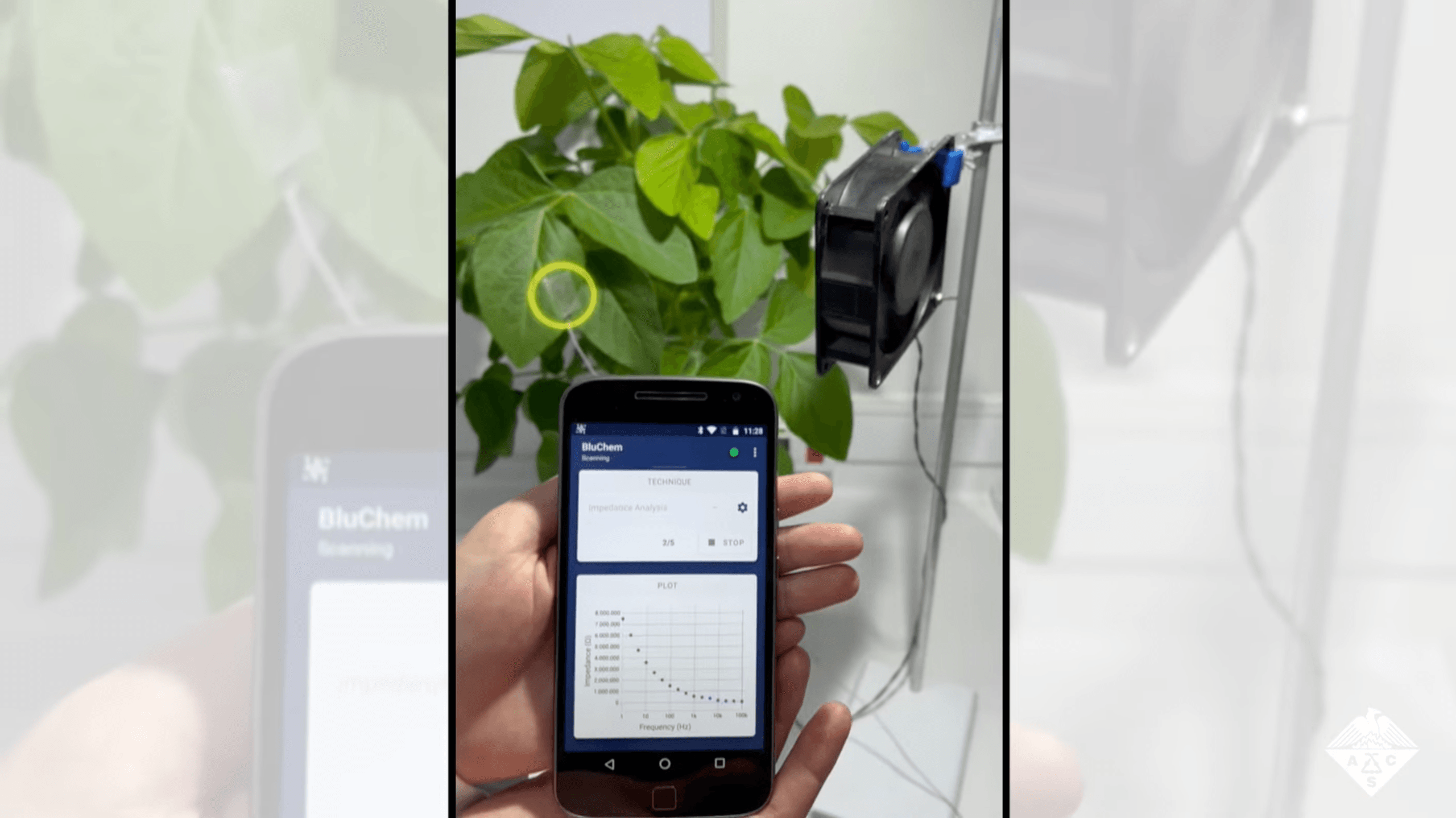Plant wearable sensors can be employed to monitor leaf health and microenvironmental factors to improve agricultural crop yields. Read about this new research published in ACS Applied Materials & Interfaces.

We need to increase agricultural crop yields because of the combination of a growing human population and climate-change-induced realities such as plant disease, warmer temperatures, and drought. This has led to a burgeoning demand for precision agricultural technologies that monitor soil, water, pathogens, and plant health—and provide actionable data in real or near-real time. Techniques that can be used in the field and provide timely feedback are highly sought after.
Wearable electrode sensors
One solution involves the use of “wearable” health sensors that adhere to a plant’s leaf. They monitor leaf health and microenvironmental factors such as temperature, humidity, and water content loss. Materials such as stacked ZnIn2S4 nanosheets have been explored, along with a stretchable metal, carbon nanotube matrix, and silicon.1,2
But getting devices to stick well to leaves is difficult—and designing a functional wearable device that can also be commercially scaled and reproduced is a tall order.
New research published in ACS Applied Materials & Interfaces shows that the right materials and technologies may help lower these barriers. Work by Barbosa et al.3 shows that nickel-based films can be used in combination with well-known microfabrication processes to make wearable electrode sensors that monitor water content loss of leaves. Water content is a key indicator of plant health and provides information about how stressed or healthy a plant is. The researchers also show that an alternative material, pyrolyzed paper, can be used to reliably measure lost water content.
Emerging tech for plant health monitoring
Other emerging technologies to monitor plant health include point-of-use techniques such as synthetic biology phytosensors that provide data on plant pathogens, toxins, and nutrients. Fluorescence and hyperspectral imaging techniques can also monitor chlorophyll, photosynthetic activity, leaf stress, pollution, and pathogens. And researchers are exploring devices that can be integrated into plants, such as microneedle electrodes and organic electrochemical transistor-based sensors, for the continual monitoring of plant health.4,5
Nanosensors based on near-infrared fluorescent single-walled carbon nanotubes have also been designed to interface with plant leaves and report on hydrogen peroxide, another key indicator of plant stress.6 Multispectral sensors are also being used on unmanned aerial vehicles to remotely detect leaf stress based on the idea that when leaves are not water stressed, they scatter comparatively more light than dehydrated leaves, based on how light moves from hydrated cell walls into external air space.7,8
References
- Lu, Y.; Xu, K.; Zhang, L.; Deguichi, M.; Shishido, H.; Arie, T.; Pan, R.; Hayashi, A.; Shen, L.; Akita, S.; Takei, K. Multimodal Plant Healthcare Flexible Sensor System. ACS Nano. 2020, 14, 10966–10975.
- Zhao, Y; Gao, S.; Zhu, J; Li, J.; Xu, K.; Cheng, H; Huang, X. Multifunctional Stretchable Sensors for Continuous Monitoring of Long-Term Leaf Physiology and Microclimate. ACS Omega. 2019, 4, 9522–9530.
- Barbosa, J. A.; Freitas, V. M. S.; Vidotta, L. H. B.; Schleder, G. R.; de Oliveira, R. A. G.; da Rocha, J. F.; Kubota, L. T.; Vieira, L. C. S.; Tolentino, H. C. N.; Neckel, I. T.; Gobbi, A. L; Santhiago, M.; Lima, R. S. Biocompatible Wearable Electrodes on Leaves toward the On-Site Monitoring of Water Loss from Plants. ACS Appl. Mater. Interfaces. 2022.
- Roper, J. M.; Garcia J. F.; Tsutsui, H. Emerging Technologies for Monitoring Plant Health in Vivo. ACS Omega. 2021, 6, 5101–5107.
- Feng, Y-X.; Chen, X.; Li, Y-W.; Zhao, H-M.; Xiang, L.; Li, H.; Cai, Q-Y.; Feng, N-X.; Mo, C-H.; Wong, M-H.
A Visual Leaf Zymography Technique for the In Situ Examination of Plant Enzyme Activity under the Stress of Environmental Pollution
J. Agric. Food Chem. 2020, 68, 14015–14024. - Wu, H.; Nißler, R.; Morris, V.; Herrmann, N.; Hu, P; Jeon, S-J.; Kruss, S.; Giraldo. J. P. Monitoring Plant Health with Near-Infrared Fluorescent H2O2 Nanosensors. Nano Lett. 2020, 20, 2432–2442.
- Stiteler, W.; Newcombe, A. Use of multispectral sensors and unmanned aerial vehicles for agricultural applications. In SciMeetings, Proceedings of the ACS Fall 2020 Virtual Meeting, Aug 17, 2020.
- Gausman, H. W.; Burke, J. J.; Quisenberry, J. E. Use of Leaf Optical Properties in Plant Stress Research. In Bioregulators: Chemistry and Uses; Ory, R. L.; Rittig, F. R., Eds.; ACS Symposium Series 257; American Chemical Society: Washington, DC, 1984, pp 215–233.
